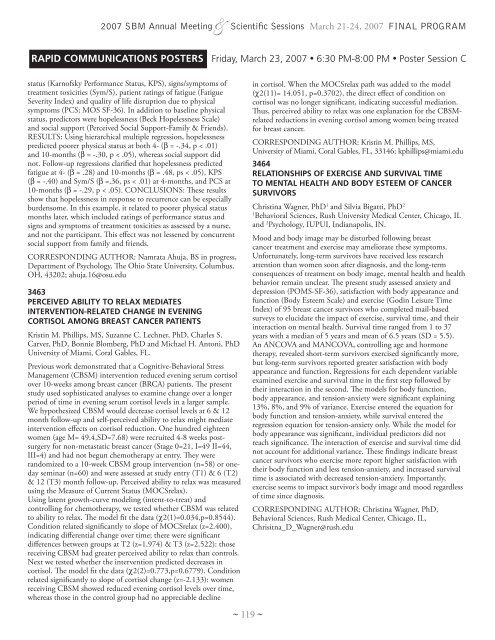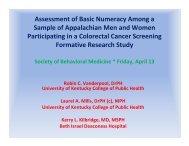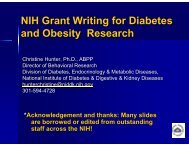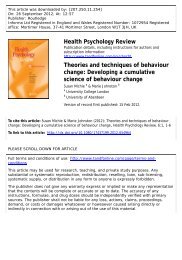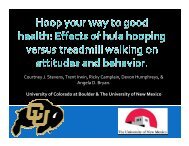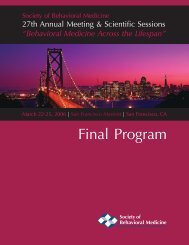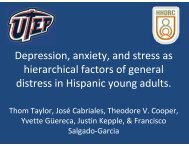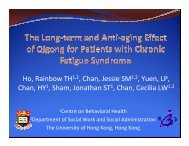2007 Final Program - Society of Behavioral Medicine
2007 Final Program - Society of Behavioral Medicine
2007 Final Program - Society of Behavioral Medicine
You also want an ePaper? Increase the reach of your titles
YUMPU automatically turns print PDFs into web optimized ePapers that Google loves.
<strong>2007</strong> SBM Annual Meeting & Scientific Sessions March 21-24, <strong>2007</strong> FINAL PROGRAM<br />
Rapid Communications Posters Friday, March 23, <strong>2007</strong> • 6:30 PM-8:00 PM • Poster Session C<br />
status (Karn<strong>of</strong>sky Performance Status, KPS), signs/symptoms <strong>of</strong><br />
treatment toxicities (Sym/S), patient ratings <strong>of</strong> fatigue (Fatigue<br />
Severity Index) and quality <strong>of</strong> life disruption due to physical<br />
symptoms (PCS; MOS SF-36). In addition to baseline physical<br />
status, predictors were hopelessness (Beck Hopelessness Scale)<br />
and social support (Perceived Social Support-Family & Friends).<br />
RESULTS: Using hierarchical multiple regression, hopelessness<br />
predicted poorer physical status at both 4- (β = -.34, p < .01)<br />
and 10-months (β = -.30, p < .05), whereas social support did<br />
not. Follow-up regressions clarified that hopelessness predicted<br />
fatigue at 4- (β = .28) and 10-months (β = .48, ps < .05), KPS<br />
(β = -.40) and Sym/S (β =.36, ps < .01) at 4-months, and PCS at<br />
10-months (β = -.29, p < .05). CONCLUSIONS: These results<br />
show that hopelessness in response to recurrence can be especially<br />
burdensome. In this example, it related to poorer physical status<br />
months later, which included ratings <strong>of</strong> performance status and<br />
signs and symptoms <strong>of</strong> treatment toxicities as assessed by a nurse,<br />
and not the participant. This effect was not lessened by concurrent<br />
social support from family and friends.<br />
CORRESPONDING AUTHOR: Namrata Ahuja, BS in progress,<br />
Department <strong>of</strong> Psychology, The Ohio State University, Columbus,<br />
OH, 43202; ahuja.16@osu.edu<br />
3463<br />
PERCEIVED ABILITY TO RELAX MEDIATES<br />
INTERVENTION-RELATED CHANGE IN EVENING<br />
CORTISOL AMONG BREAST CANCER PATIENTS<br />
Kristin M. Phillips, MS, Suzanne C. Lechner, PhD, Charles S.<br />
Carver, PhD, Bonnie Blomberg, PhD and Michael H. Antoni, PhD<br />
University <strong>of</strong> Miami, Coral Gables, FL.<br />
Previous work demonstrated that a Cognitive-<strong>Behavioral</strong> Stress<br />
Management (CBSM) intervention reduced evening serum cortisol<br />
over 10-weeks among breast cancer (BRCA) patients. The present<br />
study used sophisticated analyses to examine change over a longer<br />
period <strong>of</strong> time in evening serum cortisol levels in a larger sample.<br />
We hypothesized CBSM would decrease cortisol levels at 6 & 12<br />
month follow-up and self-perceived ability to relax might mediate<br />
intervention effects on cortisol reduction. One hundred eighteen<br />
women (age M= 49.4,SD=7.68) were recruited 4-8 weeks postsurgery<br />
for non-metastatic breast cancer (Stage 0=21, I=49 II=44,<br />
III=4) and had not begun chemotherapy at entry. They were<br />
randomized to a 10-week CBSM group intervention (n=58) or oneday<br />
seminar (n=60) and were assessed at study entry (T1) & 6 (T2)<br />
& 12 (T3) month follow-up. Perceived ability to relax was measured<br />
using the Measure <strong>of</strong> Current Status (MOCSrelax).<br />
Using latent growth-curve modeling (intent-to-treat) and<br />
controlling for chemotherapy, we tested whether CBSM was related<br />
to ability to relax. The model fit the data (χ2(1)=0.034,p=0.8544).<br />
Condition related significantly to slope <strong>of</strong> MOCSrelax (z=2.400),<br />
indicating differential change over time; there were significant<br />
differences between groups at T2 (z=1.974) & T3 (z=2.522): those<br />
receiving CBSM had greater perceived ability to relax than controls.<br />
Next we tested whether the intervention predicted decreases in<br />
cortisol. The model fit the data (χ2(2)=0.773,p=0.6779). Condition<br />
related significantly to slope <strong>of</strong> cortisol change (z=-2.133): women<br />
receiving CBSM showed reduced evening cortisol levels over time,<br />
whereas those in the control group had no appreciable decline<br />
~ 119 ~<br />
in cortisol. When the MOCSrelax path was added to the model<br />
(χ2(11)= 14.051, p=0.3702), the direct effect <strong>of</strong> condition on<br />
cortisol was no longer significant, indicating successful mediation.<br />
Thus, perceived ability to relax was one explanation for the CBSMrelated<br />
reductions in evening cortisol among women being treated<br />
for breast cancer.<br />
CORRESPONDING AUTHOR: Kristin M. Phillips, MS,<br />
University <strong>of</strong> Miami, Coral Gables, FL, 33146; kphillips@miami.edu<br />
3464<br />
RELATIONSHIPS OF EXERCISE AND SURVIVAL TIME<br />
TO MENTAL HEALTH AND BODY ESTEEM OF CANCER<br />
SURVIVORS<br />
Christina Wagner, PhD 1 and Silvia Bigatti, PhD 2<br />
1<br />
<strong>Behavioral</strong> Sciences, Rush University Medical Center, Chicago, IL<br />
and 2 Psychology, IUPUI, Indianapolis, IN.<br />
Mood and body image may be disturbed following breast<br />
cancer treatment and exercise may ameliorate these symptoms.<br />
Unfortunately, long-term survivors have received less research<br />
attention than women soon after diagnosis, and the long-term<br />
consequences <strong>of</strong> treatment on body image, mental health and health<br />
behavior remain unclear. The present study assessed anxiety and<br />
depression (POMS-SF-36), satisfaction with body appearance and<br />
function (Body Esteem Scale) and exercise (Godin Leisure Time<br />
Index) <strong>of</strong> 95 breast cancer survivors who completed mail-based<br />
surveys to elucidate the impact <strong>of</strong> exercise, survival time, and their<br />
interaction on mental health. Survival time ranged from 1 to 37<br />
years with a median <strong>of</strong> 5 years and mean <strong>of</strong> 6.5 years (SD = 5.5).<br />
An ANCOVA and MANCOVA, controlling age and hormone<br />
therapy, revealed short-term survivors exercised significantly more,<br />
but long-term survivors reported greater satisfaction with body<br />
appearance and function. Regressions for each dependent variable<br />
examined exercise and survival time in the first step followed by<br />
their interaction in the second. The models for body function,<br />
body appearance, and tension-anxiety were significant explaining<br />
13%, 8%, and 9% <strong>of</strong> variance. Exercise entered the equation for<br />
body function and tension-anxiety, while survival entered the<br />
regression equation for tension-anxiety only. While the model for<br />
body appearance was significant, individual predictors did not<br />
reach significance. The interaction <strong>of</strong> exercise and survival time did<br />
not account for additional variance. These findings indicate breast<br />
cancer survivors who exercise more report higher satisfaction with<br />
their body function and less tension-anxiety, and increased survival<br />
time is associated with decreased tension-anxiety. Importantly,<br />
exercise seems to impact survivor’s body image and mood regardless<br />
<strong>of</strong> time since diagnosis.<br />
CORRESPONDING AUTHOR: Christina Wagner, PhD,<br />
<strong>Behavioral</strong> Sciences, Rush Medical Center, Chicago, IL,<br />
Chrisitna_D_Wagner@rush.edu


